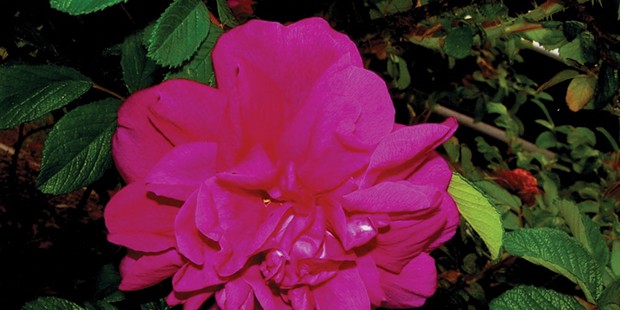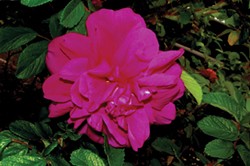[
{
"name": "Top Stories Video Pair",
"insertPoint": "7",
"component": "17087298",
"parentWrapperClass": "fdn-ads-inline-content-block",
"requiredCountToDisplay": "1"
}
]
What are low-maintenance plants? These are plants that are hardy in your region and adapted to local soil and climate conditions (think native plants); plants that thrive without heavy watering or fertilizing; plants that resist or tolerate insect and disease damage (in our area, primarily slugs and snails, deer, and powdery mildew); plants that require infrequent or no deadheading, pruning, or division; plants that are relatively long-lived; plants that don't require staking; and plants that are not overly aggressive.
Not every plant in your garden has to meet these criteria, but it's to your advantage if most do. If one of your favorite plants fails these tests, you can sometimes find a way to include it without incurring a lot of maintenance. For instance, I am fond of roses, but they can be problematic in our climate. Therefore, I have limited myself to just one in my garden — an old-fashioned Rosa rugosa that is generally problem-free and has wonderfully fragrant, magenta blossoms.
Trees and shrubs
Trees and shrubs usually cover more ground and require less frequent maintenance than annuals and perennials. Trees and shrubs also give structure to the landscape and provide important shelter for birds. When I need to cover a lot of ground, I often turn to woody shrubs that I consider the backbone of low-maintenance gardens. These include abelia, Mexican orange and a selection of low-growing shrubs such as rosemary, Goldflame spiraea, Australian fuchsia, grevillea, breath of heaven, and 'Wheeler's Dwarf' tobira. Native plants in this category are dwarf coyote brush, ceanothus, manzanita, coffeeberry, ninebark, hazelnut, toyon, red-flowering currant, Pacific wax myrtle and evergreen huckleberry. Most of these plants require attention only once a year, and many are drought tolerant.
Planting and plant care
When it comes to planting, find out how big a plant can grow before putting it in the ground — check the label on each nursery plant, look up the plant online or in a reference book, or ask an experienced gardener. This is an important but often overlooked step. A common problem is when someone plants a vigorous escallonia, with the potential of growing to 12 feet wide or more, close to a sidewalk or walkway. The result: a plant that must be trimmed frequently and is often cut back so severely that it becomes an unsightly clump of twigs. Plants don't always grow to the exact size they're "supposed" to, but a little research will give you an approximate idea of what to expect.
Allowing trees and shrubs to grow into their natural forms generally requires less maintenance than shearing them into formal shapes. And, in most landscapes, I find the natural shapes of shrubs more attractive. That said, it is important to train young trees properly to keep them healthy and to reduce on-going maintenance down the line. They should be pruned to avoid narrow crotches and to keep them open for good air circulation and sun penetration.
Automated irrigation systems not only result in less time spent watering but are vital in conserving water. Drip irrigation is the most efficient method, though I have also had good results with soaker hoses. Some systems come with electronic programmable timers, but manual timers — similar to kitchen timers — are simpler and less expensive.
It's helpful to group plants with similar needs close to each other, so when it comes time to deadhead or prune you don't have to trudge all over the garden to get the job done. If you have a large landscape, consider stashing tools at more than one location. Some people keep small hand tools in a metal mailbox or other container in far-flung areas of the garden, so if they run across a plant that needs attention, the tools are nearby.
What about lawns?
You can reduce lawn maintenance by installing a fairly substantial edging to separate lawn from adjacent planting beds. This keeps lawn grasses from creeping into the beds. If you install a brick or concrete edging that is low enough to run a lawn mower over, it eliminates the need to weed-whack along the edges. It's also a good idea to make sure lawn areas are laid out in a shape that makes them easy to mow.
Consider replacing an older lawn with some of the newer turf options. With a little research you can find ecology or eco-lawn mixes that have been developed to suit our growing conditions and use less water and fertilizer than standard lawn mixes. They also require less frequent mowing.
Gardening in the golden years
Garden maintenance becomes a more pressing issue as we grow older, when we may need to step back and look at the garden with an eye to reducing the required maintenance rather than giving up on the garden altogether. As an example, in one section of my yard I had six lavender plants with pink flowers. I enjoyed these plants, but I removed them after several years when the annual pruning they required became too burdensome. In their place, I planted a ground cover Ceanothus ('Yankee Point') — an evergreen, drought-tolerant plant that can grow 8 to 10 feet across and needs little maintenance.
The thoughtful application of low-maintenance gardening strategies may require us to sacrifice some of our plants. But that seems a fair price to pay if it enables us to retain the gardens that enrich our lives and our communities.
Donna Wildearth is the owner of Garden Visions Landscape Design in Eureka. Visit her website at www.gardenvisions.biz.
Comments
Showing 1-1 of 1
more from the author
-
Gardening for Caterpillars?
- Dec 15, 2022
-
Going Wild in the Garden
- May 25, 2017
-
Turning the Page on Native Plants
- Apr 20, 2017
- More »

































